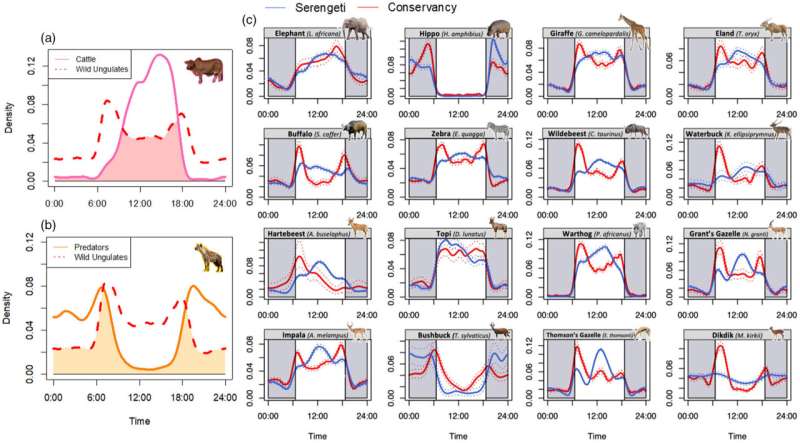This article has been reviewed according to Science X's editorial process and policies. Editors have highlighted the following attributes while ensuring the content's credibility:
fact-checked
peer-reviewed publication
trusted source
proofread
From dusk to dawn, humans squeeze wildlife into temporal periphery

As human densities increase around the world, wildlife species are becoming more nocturnal to compensate. These adaptations allow wildlife to live in human-altered habitats but may result in unseen costs. Researchers at the University of Minnesota College of Biological Sciences conducted a case study on the conflict between humans and wildlife in East Africa better to understand the impact of human activities on wildlife.
The research, published in the Journal of Animal Ecology, was conducted in communal conservation areas north of Kenya's Maasai Mara. Mara conservancies are communally owned and leased by Maasai landowners. Using remote cameras, the team studied the movement of wildlife through the area. They then compared the activity patterns of sixteen large herbivore species—ranging in size from the tiny dik-dik to the elephant—in protected versus pastoralist habitats in the East African savanna.
The team found that:
- As livestock were primarily diurnal and predators primarily nocturnal in pastoralist habitats, species that decreased their overlap with livestock were more likely to increase their overlap with potential predators.
- Caught between diurnal pastoralists and nocturnal predators, herbivores appear to favor dawn and dusk, suggesting cattle have a homogenizing influence on daily activity patterns.
"Temporal niche separation may represent an effective coping strategy for wildlife living with humans in this region," said Abby Guthmann, co-author and doctoral candidate in the College of Biological Sciences. "However, regions with the heaviest livestock grazing may impose energy costs too high for wildlife. 'Conservation success' can be a moving target, and managers will need to temper the influence of livestock through both space and time."
The research shows how cohabitation with livestock can change the daily behavior of wild herbivores. The findings have implications for community-level interactions and can help managers address conflict between humans and wildlife in pastoral areas, particularly in East Africa, where both ecotourism and livestock are essential economic pillars.
Future research may explore the consequences of temporal activity shifts, such as metabolic and nutritional constraints on herbivores, as well as how the presence of livestock alters the diets of their wild competitors.
More information: Abby Guthmann et al, Livestock activity shifts large herbivore temporal distributions to their crepuscular edges, Journal of Animal Ecology (2023). DOI: 10.1111/1365-2656.14034
Journal information: Journal of Animal Ecology
Provided by University of Minnesota



















